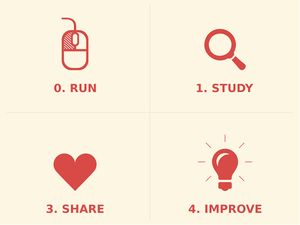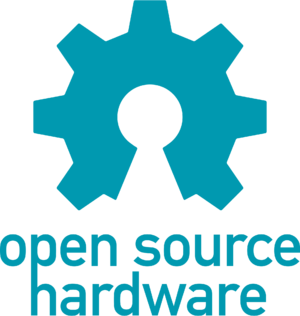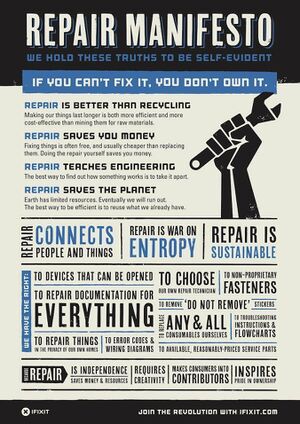Four freedoms: Difference between revisions
From
No edit summary |
No edit summary |
||
| (25 intermediate revisions by the same user not shown) | |||
| Line 1: | Line 1: | ||
[[File:-four-freedoms-of-free-software-redux.jpg|thumb]] | [[File:-four-freedoms-of-free-software-redux.jpg|thumb]] | ||
[[File:1920px-Open-source-hardware-logo.svg.png|thumb]] | |||
[[File:Repair manifesto.jpg|thumb]] | |||
The [http://www.gnu.org/philosophy/free-sw.html Free Software Definition] describes the four software freedoms: | |||
Replimat seeks to extend the paradigm of Free Software | * The '''freedom to run''' the program as you wish, for any purpose. | ||
* The '''freedom to study''' how the program works, and change it so it does your computing as you wish. Access to the source code is a precondition for this. | |||
* The '''freedom to redistribute copies''' so you can help others. | |||
* The '''freedom to distribute copies of your modified versions''' to others. By doing this you can give the whole community a chance to benefit from your changes. Access to the source code is a precondition for this. | |||
Replimat seeks to extend the paradigm of [https://en.wikipedia.org/wiki/Free_and_open-source_software Free, Libre, and Open Source Software] into [https://en.wikipedia.org/wiki/Open-source_hardware Open Hardware] and the [https://en.wikipedia.org/wiki/Open-design_movement open design movement] by applying the four software freedoms to physical goods and processes. Re-contextualized around physical goods, the freedoms become: | |||
* The '''freedom to use'''. Run or otherwise execute the software, product, or process. | * The '''freedom to use'''. Run or otherwise execute the software, product, or process. | ||
* The '''freedom to inspect''' or view | * The '''freedom to inspect''' or view how the object functions in the preferred format for making changes. This stems from the freedom to study how the program works, and change it to make it do what you wish. Access to the source code such as CAD files, text documents, spreadsheets, calculations, instructions, etc. is a necessary prerequisite for making substantive changes. | ||
* The '''freedom to modify'''. This is a big point: making improvements or adaptation is a key to distributing value. | * The '''freedom to modify'''. This is a big point: making improvements or adaptation is a key to distributing value. | ||
* Economic freedom. The '''freedom to sell'''. Freedom distribute copies of your modified versions to others. By doing this you can give the whole community a chance to benefit from your changes. Access to the source code is a precondition for this. | * Economic freedom. The '''freedom to sell'''. Freedom distribute copies of your modified versions to others. By doing this you can give the whole community a chance to benefit from your changes. Access to the source code is a precondition for this. | ||
The four essential freedoms enable the fundamental creative processes: '''copying''', '''transformation''', and '''combination''' as outlined in | The four essential freedoms enable the fundamental creative processes: '''copying''', '''transformation''', and '''combination''' as outlined in Everything is a Remix: | ||
<youtube>nJPERZDfyWc</youtube><br> | |||
====Replimat Licenses==== | ====Replimat Licenses==== | ||
* [https://creativecommons.org/licenses/by-sa/4.0/ Creative Commons Attribution-ShareAlike International] | * [https://creativecommons.org/licenses/by-sa/4.0/ Creative Commons Attribution-ShareAlike International] | ||
* [https://www.gnu.org/licenses/agpl-3.0.en.html GNU Affero General Public License] | * [https://www.gnu.org/licenses/agpl-3.0.en.html GNU Affero General Public License v3+] | ||
* [https://tapr.org/the-tapr-open-hardware-license/ TAPR Open Hardware License] | * [https://tapr.org/the-tapr-open-hardware-license/ TAPR Open Hardware License] | ||
| Line 24: | Line 29: | ||
* [http://www.gnu.org/philosophy/free-sw.html Free Software Definition] | * [http://www.gnu.org/philosophy/free-sw.html Free Software Definition] | ||
* [https://people.debian.org/~bap/dfsg-faq.html Debian Free Software Guidelines] | * [https://people.debian.org/~bap/dfsg-faq.html Debian Free Software Guidelines] | ||
* [https://www.ifixit.com/Manifesto iFixit Repair Manifesto] | * [https://www.ifixit.com/Manifesto iFixit Repair Manifesto] | ||
* [https://freedom-to-tinker.com/ Freedom to Tinker] | |||
* [https://wiki.opensourceecology.org/wiki/4_freedoms OpenSourceEcology 4 Freedoms] | * [https://wiki.opensourceecology.org/wiki/4_freedoms OpenSourceEcology 4 Freedoms] | ||
* [https://freedomdefined.org/Licenses/NC#The_Case_for_Free_Use:_Reasons_Not_to_Use_a_Creative_Commons_-NC_License The Case for Free Use: Reasons Not to Use a Creative Commons NC License] | |||
* Bradshaw, Simon; A. Bowyer and P. Haufe, “The Intellectual Property Implications of Low-Cost 3D Printing”, 7:1 SCRIPTed 5, 2010. | |||
* de Bruijn, Erik. “Fab It Yourself: Adapters & Consumer Lock-In”. Blog.erikdebruijn.nl, 13 September 2010. | |||
* Hanna, Peter. “The next Napster? Copyright questions as 3D printing comes of age”. Arstechnica.com, April 2011. | |||
* Ross, Valerie. [https://www.discovermagazine.com/technology/can-you-patent-a-shape-3d-printing-on-collision-course-with-intellectual-property-law “Can You Patent a Shape? 3D Printing on Collision Course With Intellectual Property Law”]. Discover Magazine, 7 April 2011. | |||
* Weinberg, Michael. “3D Printing Settlers of Catan is Probably Not Illegal: Is This a Problem?”. PublicKnowledge.org, 28 January 2011. | |||
* Weinberg, Michael. [https://www.publicknowledge.org/blog/it-will-be-awesome-if-they-dont-screw-it-up-3d-printing “It Will Be Awesome if They Don’t Screw it Up: 3D Printing, Intellectual Property, and the Fight Over the Next Great Disruptive Technology”]. PublicKnowledge.org, 10 November 2010. | |||
* [[:File:Open Source Hardware Business Models (Gnusha RepLab, et al.).pdf|Open Source Hardware Business Models]] | |||
* [https://en.wikipedia.org/wiki/Business_models_for_open-source_software Business models for open source software] | |||
* [https://makesourcenotcode.github.io/freedom_respecting_technology.html Freedom Respecting Technology] | |||
Latest revision as of 05:49, 1 July 2023



The Free Software Definition describes the four software freedoms:
- The freedom to run the program as you wish, for any purpose.
- The freedom to study how the program works, and change it so it does your computing as you wish. Access to the source code is a precondition for this.
- The freedom to redistribute copies so you can help others.
- The freedom to distribute copies of your modified versions to others. By doing this you can give the whole community a chance to benefit from your changes. Access to the source code is a precondition for this.
Replimat seeks to extend the paradigm of Free, Libre, and Open Source Software into Open Hardware and the open design movement by applying the four software freedoms to physical goods and processes. Re-contextualized around physical goods, the freedoms become:
- The freedom to use. Run or otherwise execute the software, product, or process.
- The freedom to inspect or view how the object functions in the preferred format for making changes. This stems from the freedom to study how the program works, and change it to make it do what you wish. Access to the source code such as CAD files, text documents, spreadsheets, calculations, instructions, etc. is a necessary prerequisite for making substantive changes.
- The freedom to modify. This is a big point: making improvements or adaptation is a key to distributing value.
- Economic freedom. The freedom to sell. Freedom distribute copies of your modified versions to others. By doing this you can give the whole community a chance to benefit from your changes. Access to the source code is a precondition for this.
The four essential freedoms enable the fundamental creative processes: copying, transformation, and combination as outlined in Everything is a Remix:
Replimat Licenses
- Creative Commons Attribution-ShareAlike International
- GNU Affero General Public License v3+
- TAPR Open Hardware License
References
- Free Software Definition
- Debian Free Software Guidelines
- iFixit Repair Manifesto
- Freedom to Tinker
- OpenSourceEcology 4 Freedoms
- The Case for Free Use: Reasons Not to Use a Creative Commons NC License
- Bradshaw, Simon; A. Bowyer and P. Haufe, “The Intellectual Property Implications of Low-Cost 3D Printing”, 7:1 SCRIPTed 5, 2010.
- de Bruijn, Erik. “Fab It Yourself: Adapters & Consumer Lock-In”. Blog.erikdebruijn.nl, 13 September 2010.
- Hanna, Peter. “The next Napster? Copyright questions as 3D printing comes of age”. Arstechnica.com, April 2011.
- Ross, Valerie. “Can You Patent a Shape? 3D Printing on Collision Course With Intellectual Property Law”. Discover Magazine, 7 April 2011.
- Weinberg, Michael. “3D Printing Settlers of Catan is Probably Not Illegal: Is This a Problem?”. PublicKnowledge.org, 28 January 2011.
- Weinberg, Michael. “It Will Be Awesome if They Don’t Screw it Up: 3D Printing, Intellectual Property, and the Fight Over the Next Great Disruptive Technology”. PublicKnowledge.org, 10 November 2010.
- Open Source Hardware Business Models
- Business models for open source software
- Freedom Respecting Technology